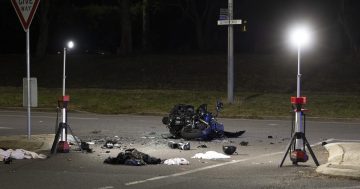
Fortunately, no one was badly hurt in this crash on Canberra Avenue on 29 March 2024. Photo: Region.
Canberra Avenue in Fyshwick has been revealed as the worst road in the ACT for crashes, according to new insurance claim data from the past 10 years.
National insurer AAMI released its ‘Decade of Driving Report’ this week, looking back at driving trends over the past decade.
It takes into account more than 4.3 million motor claims from across the country between January 2014 and December 2023 to “shine a light on the country’s most dangerous crash hotspots”.
The results are ranked nationally and then by each state and territory.
After Canberra Avenue, the Monaro Highway near Hume was the second on the list of the ACT’s top 10 crash hotspots.
It was followed by Gundaroo Drive in Gungahlin, the Monaro Highway again (near Fyshwick this time), Gungahlin Drive, Parkes Way, Northbourne Avenue, Drakeford Drive in Tuggeranong, Horse Park Drive in Gungahlin and Newcastle Street, Fyshwick.
Canberra Avenue also occupied fifth place in the nation’s most dangerous roads of the past decade.
Plenty Road, Bundoora, in Melbourne’s north-east took out the top spot, followed by the Hume Highway near Liverpool, NSW, Bruce Highway in Rockhampton, Queensland, the Albany Highway near Cannington in WA, Marion Road in South Australia, Sandy Bay Road in Tasmania, and the Stuart Highway in the Northern Territory.

Monaro Highway appears an unlucky twice. Photo: AAMI.
AAMI Motor Claims manager Leah James wasn’t surprised by the results for Canberra Avenue.
“The major road is a primary link between the ACT and NSW, and it also passes historical landmarks and travels through shopping precincts so traffic can be heavy and congested, which has obviously led to the number of collisions,” she said.
“Notable crash hotspots over the decade include Horse Park Drive in Gungahlin, which started 2014 at 16, unfortunately, rising through the ranks to close out 2023 10 spots higher at number six.”
Nationally, Friday emerged as the worst day of the week for crashes (16%), followed by Thursday and Wednesday.
The worst time of day for a crash has stubbornly remained the same over the past 10 years – afternoons between 1 pm and 4:30 pm. Mornings from 9:30, and late afternoon between 4:30 and 8 pm, are the other worst times to be on the road.
The most common collision on Aussie roads was nose-to-tail crashes (26%), with a further 19 per cent of drivers failing to give way and 17 per cent accidentally damaging cars while parking.
Male drivers (54%) were more likely to have accidents than females (46%), while older drivers aged 65-plus were the most dangerous behind the wheel, with more than a quarter (26%) of claims attributed to them.

Friday afternoons are the most dangerous times on our roads. Photo: AAMI.
The ACT echoed many of these same statistics.
Friday afternoon is the most dangerous time to be on our roads, and males are most likely to be involved in an accident (51 per cent). Nose-to-tail prangs are the most common (28%), with accidental damage while parked and a crash with a stationary object tied at 17 per cent.
Those aged between 35 and 44 are most often to blame (23 per cent).
“We want to remind drivers in the ACT to remain vigilant behind the wheel and leave plenty of distance between you and the car in front,” Ms James concluded.
“What we hope to achieve with our AAMI Decade of Driving Report is to bring awareness to where, when and how accidents occur so that Aussie drivers can be better informed and educated on how to drive more safely.”




















